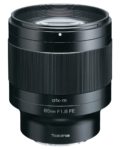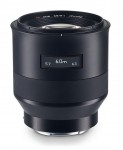Announced
Production status
Original name
System
Class
Pros and cons
Genres or subjects of photography
Recommended slowest shutter speed when shooting static subjects handheld
Sigma 85mm F/1.4 DG DN | A
Short telephoto prime lens • Digital era
Abbreviations
| DG | The lens is designed for 35mm digital cameras but can be also used on APS-C digital cameras. |
| DN | The lens is optimized for cameras with a short flange back distance. |
| | A | Belongs to the Art series lenses. |
Model history
| ■Sigma 85mm F/1.4 DG HSM | A | A | 14 - 12 | 0.85m | ⌀86 | 2018 ● | |
| ■Sigma 85mm F/1.4 DG DN | A | A | 15 - 11 | 0.85m | ⌀77 | 2020 ● | |
Specification


| Optical design: | |
| 85mm | |
| F/1.4 | |
| 35mm full frame | |
| Leica L | |
| Sony E | |
| 28.5° (35mm full frame) | |
| 15 elements in 11 groups | |
| 1 ASPH, 5 SLD | |
| On Leica T/TL/CL APS-C [1.53x] cameras: | |
35mm equivalent focal length: | 130.1mm (in terms of field of view) |
35mm equivalent speed: | F/2.1 (in terms of depth of field) |
Diagonal angle of view: | 18.9° |
| On Sony NEX/a/ZV APS-C [1.53x] cameras: | |
35mm equivalent focal length: | 130.1mm (in terms of field of view) |
35mm equivalent speed: | F/2.1 (in terms of depth of field) |
Diagonal angle of view: | 18.9° |
| Diaphragm mechanism: | |
Diaphragm type: | Automatic |
Aperture control: | Aperture ring (Manual settings + Auto Exposure setting) |
| 11 (eleven) | |
| Focusing: | |
| 0.85m | |
| 1:8.4 | |
Focusing modes: | Autofocus, manual focus |
Autofocus motor: | Stepping motor |
Manual focus control: | Focusing ring |
Focus mode selector: | AF - MF |
Manual focus override in autofocus mode: | Determined by the camera |
| Optical Stabilizer (OS): | |
| - | |
| Physical characteristics: | |
| 630g (Leica L) | |
| 625g (Sony E) | |
| ⌀82.8×94.1mm (Leica L) | |
| ⌀82.8×96.1mm (Sony E) | |
| Dust-proof and water-resistant barrel | |
| - | |
| Accessories: | |
| Screw-type 77mm | |
| LH828-02 - Bayonet-type round | |
| Not compatible |
Source of data
- Manufacturer's technical data.
Manufacturer description
The 85mm F1.4 DG DN | Art combines a clear and delicate rendering performance, which is requisite for portrait photography, with beautiful, rich bokeh effects only possible with lenses such as a large-diameter F1.4, at a level that will satisfy both professional and advanced amateur photographers. The focal length of 85mm and significant bokeh effect at F1.4 brightness allow the users’ subjects to stand out in a complementary fashion, which is one of the essences of taking portrait photography, so users can enjoy it to the fullest.
In addition to the fast and consistent AF response, the mirrorless-exclusive design of the 85mm F1.4 DG DN | Art has realized a lightweight and compact lens body that defies convention. And its small body is packed with a range of functionalities, including a dust- and splash-proof structure, supported by an excellent build quality.
The 85mm F1.4 DG DN | Art is SIGMA's new “ultimate portrait lens” for the mirrorless age. And with it, SIGMA proposes a whole new world of possibilities provided by this “85mm F1.4 lens for everyday use,” thanks to the unprecedented level of portability, free from size- or weight-related limitations.
85mm F1.4 is a specification almost synonymous with a portrait lens. With the Art line lenses, SIGMA pursues the highest optical performance possible and has devoted the latest optical design technologies, as well as the production technologies of the Aizu factory, SIGMA's only production site, to the development of these lenses. The result is a detailed image critical for portrait photography that is achieved at a level that will satisfy both professional and advanced amateur photographers.
In addition to five SLD (Special Low Dispersion) elements and one aspherical lens, the 85mm F1.4 DG DN | Art has incorporated the latest high refractive index glass, which works to thoroughly correct aberrations that cannot be handled by the correction functionality on the camera side. With a particular emphasis given to the correction of axial chromatic aberration, users will enjoy sharp images with no color bleeding, all the way up to the maximum aperture of F1.4.
The high resolving power that covers the entire image from the center to the edges ensures sharpness of the area in focus, and coupled with the significant bokeh effect produced by the F-value of 1.4 brings out the users’ subject in an evocative way.
The numerous rounds of ray-trace simulation, as well as repeated real-world testing, have given the 85mm F1.4 DG DN | Art its ability to minimize ghosting, ensuring clear, sharp images even when shooting in backlit conditions.
With the ability to shoot from the maximum aperture of F1.4 without worrying about image quality, users can focus on the camera operations to realize their artistic expressions, such as the adjustment of exposure and depth of field. This new lens indeed delivers a level of optical performance truly worthy of the name of 85mm F1.4 Art.
The 85mm F1.4 DG DN | Art weighs 630g/ 22.2oz., with a filter size of 77mm and a body length of 94.1mm/ 3.7in. Designed exclusively for mirrorless cameras, it has a “large lens diameter and superb optical performance” and “a lightweight and compact body,” a combination which has long been difficult to achieve.
The AF motor system employs a stepping motor which is optimized for both phase detection AF and contrast AF. Not only does this provide a smooth shooting experience only possible with a mirrorless camera, such as face/eye detection AF, but it has also made the lens body itself much smaller, as the focus lens has been made small to better suit a stepping motor. Furthermore, by making the most of the in-camera aberration correction functionalities, SIGMA was able to concentrate on the correction of aberration that could be handled by the optical system alone, which further contributed to making the lens smaller in size.
With such a lightweight and small body, users can now take out a large-diameter 85mm F1.4 lens for an everyday use such as taking snapshots. The 85mm F1.4 DG DN | Art invites users to enjoy photography in an unconventional way.
This compact lens is packed with a range of functionalities that will satisfy both professional and advanced amateur photographers. The 85mm F1.4 DG DN | Art has newly introduced an “Iris ring lock switch.” This prevents from unintended movement of the iris ring during shooting, allowing users to devote their attention to the creation of their image. The Iris ring is mounted with a de-click function for removing clicks by the Iris Ring Click Switch, enabling seamless operations that are especially useful such as during video shooting. Furthermore, the “Focus Mode Switch” on the lens body and the “AFL button” that allows various functions to be assigned from a camera body will also assist users’ shooting.
*1 When turned ON at the position A, the iris ring is locked at A. When turned ON at a position other than A, it is locked within the range between the maximum to minimum apertures and will not engage at the position A.
In addition to the dust- and splash-proof structure, the lens uses materials such as aluminum and TSC (Thermally Stable Composite) where they are best suited, achieving a level of build quality that is worthy of the Art line. In addition to the durability of the body, the lens pursues quality in terms of how users “feel” as well, such as the smooth motion in which each ring or switch works, and the precise hand feeling. The 85mm F1.4 DG DN | Art helps ensure users a smooth shooting experience in every condition.
Matching the optical characteristics of the lens, this function performs in-camera corrections of peripheral illumination, chromatic aberrations, distortion, and more, to further enhance image quality.
The 11-blade rounded diaphragm creates an attractive blur in the out-of-focus areas of the image.
From an early stage in the lens design process, flare and ghosting have been measured to establish an optical design resistant to strong incident light sources such as backlighting. SIGMA’s Super Multi-Layer Coating reduces flare and ghosting to help photographers produce sharp and high contrast images even in back light conditions.
The brass mount combines high precision with rugged construction. Its treated surfaces and enhanced strength contribute to the exceptional durability of the lens.
Features a hood with lock to prevent dropping the hood.
This product is developed, manufactured and sold based on the specifications of E-mount which was disclosed by Sony Corporation under the license agreement with Sony Corporation.
Travellers' choice
- Ultra fast speed (F/1.4)
- Lightweight (625g)
- Dust-proof and water-resistant barrel
From the editor
Unlike the 85mm F/1.4 DG HSM | A model, which was originally designed for 35mm full-frame digital SLR cameras only and was later released for mirrorless cameras, the 85mm F/1.4 DG DN | A was developed by Sigma specifically for mirrorless cameras. As a result, this moderate telephoto lens is almost 2x lighter and much more compact than the DG HSM | A. It also received weather sealing which is a quite useful feature for a lens designed for shooting portraits, because portrait photography does not always take place in a studio.
Compared to other short telephoto prime lenses in the Leica L system
- Fastest speed (F/1.4), along with 2 other models
Other short telephoto prime lenses in the Leica L system
Sorted by focal length and speed, in ascending order
| ■Leica L mount (7) | |||||||||
| Sigma 65mm F/2 DG DN | C • ⌀62 | 2020 ● | Compare | 4 | 2 | |||||
|
|
|||||||||
| Leica APO-Summicron-SL 75mm F/2 ASPH. [11178] • E67 | 2018 ● | Compare | 4 | 1 | |||||
|
|
|||||||||
| Panasonic Lumix S 85mm F/1.8 • ⌀67 | 2020 ● | Compare | 2 | 0 | |||||
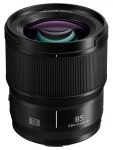
|
|||||||||
| Sigma 85mm F/1.4 DG HSM | A • ⌀86 | Pro | 2018 ● | Compare | 1 | 4 | ||||
|
|
|||||||||
| Sigma 90mm F/2.8 DG DN | C • ⌀55 | 2021 ● | Compare | 4 | 2 | |||||
|
|
|||||||||
| Leica APO-Summicron-SL 90mm F/2 ASPH. [11179] • E67 | 2018 ● | Compare | 4 | 1 | |||||

|
|||||||||
| Sigma 105mm F/1.4 DG HSM | A • ⌀105 | Pro | 2018 ● | Compare | 1 | 4 | ||||
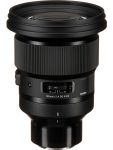
|
|||||||||

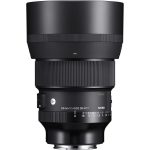
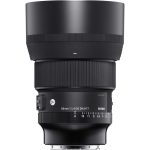
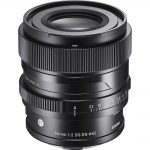
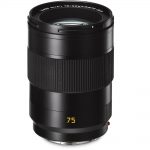

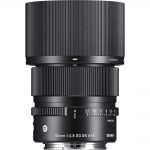

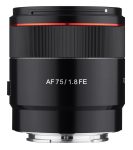
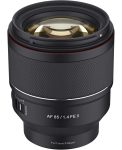
![Sony FE 85mm F/1.4 GM [SEL85F14GM]](https://lens-db.com/wp-content/uploads/2016/02/1454514369000_IMG_582638-150x150.jpg)
![Sony FE 85mm F/1.8 [SEL85F18]](https://lens-db.com/wp-content/uploads/2017/02/1486480887000_1317562-150x150.jpg)
